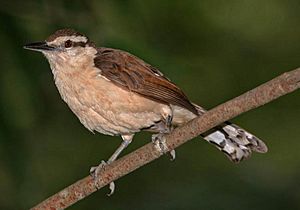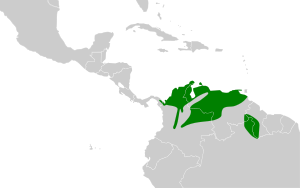Bicolored wren facts for kids
Quick facts for kids Bicolored wren |
|
|---|---|
 |
|
| in Barquisimeto, Venezuela | |
| Conservation status | |
| Scientific classification | |
| Genus: |
Campylorhynchus
|
| Species: |
griseus
|
 |
|
The bicolored wren (Campylorhynchus griseus) is a cool type of bird that belongs to the wren family, called Troglodytidae. You can find this bird living in several South American countries. These include Colombia, Venezuela, Guyana, and Brazil.
Contents
Meet the Bicolored Wren Family
Birds are grouped into families and types, which is called taxonomy. The bicolored wren has six different types, called subspecies. Think of them like different cousins in the same family! Each one has slight differences, often in where they live or how they look.
Different Types of Bicolored Wrens
- C. g. albicilius
- C. g. bicolor
- C. g. griseus
- C. g. minor
- C. g. pallidus
- C. g. zimmeri
Sometimes, scientists thought the bicolored wren might be the same species as the giant wren. They are very similar! One of the subspecies, C. g. zimmeri, seems to be a mix between two other types.
What Does the Bicolored Wren Look Like?
The bicolored wren is a pretty big bird for a wren! It's the largest wren in South America. Only the giant wren is bigger in the whole wren family. This bird is about 21 to 22 centimeters (8 to 8.7 inches) long. It weighs between 37 and 46.5 grams (1.3 to 1.6 ounces). Both male and female wrens look very similar.
Colors and Markings
Adult bicolored wrens have dark chocolate-colored tops of their heads and necks. Their upper bodies are a lighter chocolate color. They have an off-white stripe above their eyes, like an eyebrow. A dark brown stripe goes right through their eye. The rest of their face is white.
Their tail is dark brown. Most of their tail feathers have a white band near the end. Their throat and entire underside are white.
Subspecies Variations
Some subspecies have slightly different colors:
- C. g. albicilius looks more rusty.
- C. g. bicolor is also rustier, but its lower back is lighter.
- C. g. minor is smaller and has a blackish-brown neck and upper back.
- C. g. pallidus is paler and more gray, with a darker head.
Young bicolored wrens, called juveniles, are grayer than the adults. Their caps are a mix of gray-brown, and their undersides are grayish-white.
Where Do Bicolored Wrens Live?
The bicolored wren lives in different parts of South America. Each subspecies lives in a specific area.
Wren Habitats
- C. g. albicilius lives in northern Colombia and northwestern Venezuela. You might even see a few in eastern Panama.
- C. g. bicolor prefers western Colombia.
- C. g. griseus is found in eastern Venezuela, western and southwestern Guyana, and northern Brazil.
- C. g. minor lives in northern Venezuela and eastern Colombia.
- C. g. pallidus is found in southern Venezuela's Amazonas State.
- C. g. zimmeri lives in central Colombia.
These wrens like areas with scattered trees and bushes. They do not live in thick forests or wide-open spaces. One subspecies, C. g. bicolor, lives in dry, thorny areas. The other types prefer more humid places. You can find them at different heights, up to 2,100 meters (6,900 feet) in Colombia and 1,600 meters (5,200 feet) in Venezuela.
How Bicolored Wrens Behave
What Do Bicolored Wrens Eat?
The bicolored wren looks for food both in trees and on the ground. They mostly eat small insects and other tiny creatures, which are called invertebrates. But they also enjoy eating plant matter, like berries!
How Do Bicolored Wrens Raise Their Young?
Bicolored wrens have two breeding seasons in Venezuela, from January to March and again from May to August. They are "cooperative breeders." This means that other family members, like brothers or sisters of the parents, help out! They help protect the nest and feed the baby birds.
Their nest is shaped like a dome and is made from grass and other plant fibers. It has an entrance on the side. They build their nests high up in trees and hide them very well. Sometimes, they even use old dome-shaped nests built by other bird species. A female bicolored wren usually lays three to five eggs.
What Do Bicolored Wrens Sound Like?
The male bicolored wren has a loud, gurgling song. It sounds like a series of bubbling notes. You can hear an example here: [1]. The female's song is similar but also includes a trill, which is a rapid up-and-down sound. Their songs can sound quite different depending on where the birds live. Their calls are often harsh and grating. You can hear an example of their calls here: [2].
Bicolored Wren Status
The IUCN (International Union for Conservation of Nature) has looked at the bicolored wren. They have assessed it as being of "Least Concern." This is good news! It means the bird is not currently in danger of disappearing.
The bicolored wren is common and can live even if its habitat changes a bit. As long as there are enough bushes, they can get along with human activities like farming and ranching.
See also
 In Spanish: Cucarachero chupahuevos para niños
In Spanish: Cucarachero chupahuevos para niños


